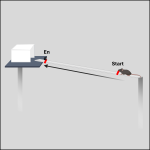Research Tip: Balance Beam for Mice Functional Assessment
 RESEARCH TIP
RESEARCH TIP
Balance beam protocol for use in the assessment of dysferlin deficient mouse models
Click to view Balance Beam Guidelines
The balance beam test measures the ability of a mouse to traverse a narrow beam between two raised platforms.
The advantages of the balance beam are in the detection of subtle deficits in motor skills and balance that may not be detected by other motor tests, such as the treadmill or rotarod, as well as the emphasis on a narrow gait, which counters the compensation mice use for their hip weakness which is to adopt wider stance. Mice with dysferlinopathy have trouble traversing the balance beam and have measurably slower crossing times than wild type mice. Dysferlin deficient mice struggle to place their hind feet on the beam and may occasionally slip off the beam or drag their torso along the beam.
Please be mindful that the balance beam and other protocols on our web site are guidelines for consideration. We encourage you to develop the balance beam assay according to your specific experiments.
Want more Research Tips? Click here to visit the Research Tips section on our web site for protocols, procedures, and advice specific or unique to dysferlin research, many in response to the questions we are often asked.
As you review our research tips, please be mindful that the field of dysferlinopathy is very young with many uncertainties and assumptions. Therefore, we encourage all researchers to keep an open mind when approaching their dysferlin research and to consider the goal of their research when assessing whether these tips are applicable.

